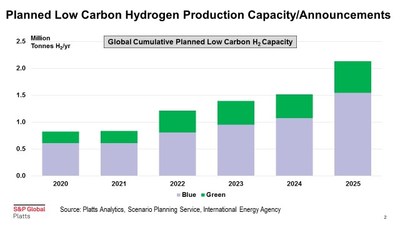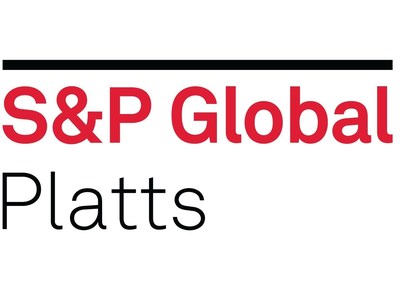Press Releases
NEW YORK, March 19, 2020 /PRNewswire/ -- S&P Global Platts ("Platts"), the leading independent provider of information, analytics and benchmark prices for the commodities and energy markets, announced it is expanding its suite of daily hydrogen price assessments to meet the needs of the marketplace and the growing interest in independent price references as the energy sector seeks to understand the economics of a clean-energy future.
On April 1, S&P Global Platts will increase its market coverage to include:
- Daily hydrogen price assessments for Japan
- Nine more daily price assessment regions for the US and Canada
- New low-carbon production pathways for Platts Netherlands hydrogen price assessment
Simon Thorne, global director of generating fuels of S&P Global Platts, said: "We recognize the important role hydrogen will play in a clean energy future. Following positive feedback from market participants, we are pleased to broaden the scope of our market coverage to provide the independence and transparency that is so critical to market development and the impartial evaluation of hydrogen as a fuel. We view the trajectory of hydrogen as similar to liquefied natural gas, where our Platts JKM™ price assessment evolved in less than 10 years from a market indicator to a global benchmark, although we expect hydrogen's evolution to be more accelerated."
S&P Global Platts was the first price reporting agency to launch hydrogen assessments, recognizing growing interest in de-carbonization and the use of hydrogen in a number of different sectors, including mobility, power generation and materials production. This expanded suite of daily hydrogen price assessments from the original suite launched in December 2019 will further help market participants evaluate the cost of hydrogen produced from up to four different production pathways at 13 different locations.
Zane McDonald, hydrogen & alternative transportation lead, S&P Global Platts Analytics, said: "Hydrogen production with carbon capture can help the energy system transition to a clean and affordable future by serving as a linkage between abundant, cost effective fossil fuels and the ever-pressing requirement to curb global emissions. As a low-carbon energy carrier, hydrogen can de-carbonize sectors that renewables and batteries alone cannot."
If any trouble seeing Graphic of Planned Low Carbon Hydrogen Production Capacity/Announcements, visit Platts website and Platts Release page.
Across the globe, governments are developing ambitious de-carbonization strategies that make low carbon hydrogen a key tool to achieve their goals. With support from both public and private sectors, significant cost declines are likely to emerge throughout the hydrogen supply chain, from production to transportation to storage.
"These cost declines will be critical in reducing CO2 emissions from sectors that have otherwise been challenging to de-carbonize, such as long haul trucking, steel production, industrial heating, long-duration power storage and marine fuels". For this to occur, low carbon hydrogen production needs to scale up dramatically from just under 2% of global supply today," said McDonald.
HYDROGEN AT NORTH AMERICAN HUBS
In addition to Japan and the Netherlands, S&P Global Platts will also publish hydrogen assessments from the following North American hubs: Alberta, Appalachia, Gulf Coast, Midcontinent, Northeast, Northern California, Northwest, Rockies, Southeast, Southern California and Upper Midwest.
Each hub will show the cost of hydrogen production through three different production pathways: steam methane reforming (SMR) without carbon capture and storage (CCS); proton exchange membrane (PEM) electrolysis; and alkaline electrolysis. The Netherlands hydrogen assessments will have a fourth production pathway: steam methane reforming with CCS.
Each production pathway will have two assessments: one reflecting just feedstock costs, using Platts existing natural gas and electricity assessments, and a second that will include assumptions for capital and operating expenses. The assessments will primarily be published in $/kg, €/kg and ¥/kg, respectively.
The new price assessments will be available through S&P Global Platts products and services, including Gas Daily, Megawatt Daily, European Gas Daily, European Power Daily, LNG Daily, Coal Trader International and other publications, as well as related market data categories.
For more information on hydrogen, access the March 18 2020 webinar here and/or contact Scott Raber at scott.raber@spglobal.com.
About S&P Global Platts
At S&P Global Platts, we provide the insights; you make better-informed trading and business decisions with confidence. We're the leading independent provider of information and benchmark prices for the commodities and energy markets. Customers in over 150 countries look to our expertise in news, pricing and analytics to deliver greater transparency and efficiency to markets. S&P Global Platts coverage includes oil and gas, power, petrochemicals, metals, agriculture and shipping.
S&P Global Platts is a division of S&P Global (NYSE: SPGI), which provides essential intelligence for individuals, companies and governments to make decisions with confidence. For more information, visit www.platts.com.
Contact
Americas: Kathleen Tanzy + 1 917-331-4607, Kathleen.tanzy@spglobal.com
SOURCE S&P Global Platts


